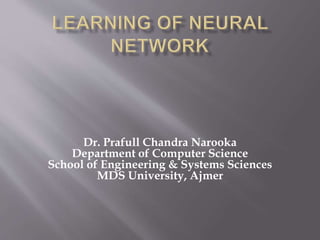
SoftComputing6
- 1. Dr. Prafull Chandra Narooka Department of Computer Science School of Engineering & Systems Sciences MDS University, Ajmer
- 2. Contents Learning Learning paradigms Supervised learning Unsupervised learning Reinforcement learning Applications areas Advantages and Disadvantages
- 3. Learning by trial‐and‐error Continuous process of: Trial: Processing an input to produce an output (In terms of ANN: Compute the output function of a given input) Evaluate: Evaluating this output by comparing the actual output with the expected output. Adjust: Adjust the weights.
- 4. Example: XOR Hidden Layer, with three neurons Output Layer, with one neuron Input Layer, with two neurons
- 5. How it works? Hidden Layer, with three neurons Output Layer, with one neuron Input Layer, with two neurons
- 6. How it works? Set initial values of the weights randomly. Input: truth table of the XOR Do Read input (e.g. 0, and 0) Compute an output (e.g. 0.60543) Compare it to the expected output. (Diff= 0.60543) Modify the weights accordingly. Loop until a condition is met Condition: certain number of iterations Condition: error threshold
- 7. Design Issues Initial weights (small random values ∈[‐1,1]) Transfer function (How the inputs and the weights are combined to produce output?) Error estimation Weights adjusting Number of neurons Data representation Size of training set
- 8. Transfer Functions Linear: The output is proportional to the total weighted input. Threshold: The output is set at one of two values, depending on whether the total weighted input is greater than or less than some threshold value. Non‐linear: The output varies continuously but not linearly as the input changes.
- 9. Error Estimation The root mean square error (RMSE) is a frequently- used measure of the differences between values predicted by a model or an estimator and the values actually observed from the thing being modeled or estimated
- 10. Weights Adjusting After each iteration, weights should be adjusted to minimize the error. – All possible weights – Back propagation
- 11. Back Propagation Back-propagation is an example of supervised learning is used at each layer to minimize the error between the layer’s response and the actual data The error at each hidden layer is an average of the evaluated error Hidden layer networks are trained this way
- 12. Back Propagation N is a neuron. Nw is one of N’s inputs weights Nout is N’s output. Nw = Nw +Δ Nw Δ Nw = Nout * (1‐ Nout)* NErrorFactor NErrorFactor = NExpectedOutput – NActualOutput This works only for the last layer, as we can know the actual output, and the expected output.
- 13. Number of neurons Many neurons: Higher accuracy Slower Risk of over‐fitting Memorizing, rather than understanding The network will be useless with new problems. Few neurons: Lower accuracy Inability to learn at all Optimal number.
- 14. Data representation Usually input/output data needs pre‐processing Pictures Pixel intensity Text: A pattern
- 15. Size of training set No one‐fits‐all formula Over fitting can occur if a “good” training set is not chosen What constitutes a “good” training set? Samples must represent the general population. Samples must contain members of each class. Samples in each class must contain a wide range of variations or noise effect. The size of the training set is related to the number of hidden neurons
- 16. Learning Paradigms Supervised learning Unsupervised learning Reinforcement learning
- 17. Supervised learning This is what we have seen so far! A network is fed with a set of training samples (inputs and corresponding output), and it uses these samples to learn the general relationship between the inputs and the outputs. This relationship is represented by the values of the weights of the trained network.
- 18. Unsupervised learning No desired output is associated with the training data! Faster than supervised learning Used to find out structures within data: Clustering Compression
- 19. Reinforcement learning Like supervised learning, but: Weights adjusting is not directly related to the error value. The error value is used to randomly, shuffle weights! Relatively slow learning due to ‘randomness’.
- 20. Applications Areas Function approximation including time series prediction and modeling. Classification including patterns and sequences recognition, novelty detection and sequential decision making. (radar systems, face identification, handwritten text recognition) Data processing including filtering, clustering blinds source separation and compression. (data mining, e-mail Spam filtering)
- 21. Advantages / Disadvantages Advantages Adapt to unknown situations Powerful, it can model complex functions. Ease of use, learns by example, and very little user domain‐specific expertise needed Disadvantages Forgets Not exact Large complexity of the network structure
- 22. Conclusion Artificial Neural Networks are an imitation of the biological neural networks, but much simpler ones. The computing would have a lot to gain from neural networks. Their ability to learn by example makes them very flexible and powerful furthermore there is need to device an algorithm in order to perform a specific task. Neural networks also contributes to area of research such a neurology and psychology. They are regularly used to model parts of living organizations and to investigate the internal mechanisms of the brain. Many factors affect the performance of ANNs, such as the transfer functions, size of training sample, network topology, weights adjusting algorithm, … Neural networks also contributes to area of research such a neurology and psychology. They are regularly used to model parts of living organizations and to investigate the internal mechanisms of the brain. Many factors affect the performance of ANNs, such as the transfer functions, size of training sample, network topology, weights adjusting algorithm, …
- 23. Conclusion Neural networks also contributes to area of research such a neurology and psychology. They are regularly used to model parts of living organizations and to investigate the internal mechanisms of the brain. Many factors affect the performance of ANNs, such as the transfer functions, size of training sample, network topology, weights adjusting algorithm, …